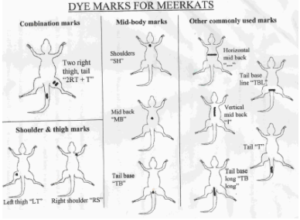 All meerkats born into the project’s focal groups are permanently marked with uniquely numbered transponders (rice-grain sized microchips detectable with a hand scanner, as used for pets), implanted under the skin at the scruff of the neck. This ensures that the animal’s identity can be ascertained throughout its life.
All meerkats born into the project’s focal groups are permanently marked with uniquely numbered transponders (rice-grain sized microchips detectable with a hand scanner, as used for pets), implanted under the skin at the scruff of the neck. This ensures that the animal’s identity can be ascertained throughout its life.
For day-to-day visual identification, dabs of black hair dye are applied on a particular part of each animal’s body. New litters of pups have their fur dyed on particular areas using a set sequence of marks. The first emerging pup (i.e. the one with the lowest ID number) has the fur on its rump (or tail-base) cut or dyed, the second pup is marked on its right thigh, the third, its left thigh, and so on. The standard sequence for pup marks is: TB (tail base), RT (right thigh), LT (left thigh), RS (right shoulder), LS (left shoulder), MB (single dab on mid back), SH (shoulders), RR (right rib), LR (left rib), T (tail), TB (tail base), TBL (tail base long line), MBL (mid back line from left to right), H (head). When pups get older we add extra marks to all the littermates such as T (tail), MB (mid-back), H (head) or SH (shoulders) to differentiate between the litters.
Dye marks are used to identify meerkats in their usual environment, i.e. amongst their family for young or female meerkats, or amongst their family and neighbouring families in case of active rovers. Marks should therefore be unambiguous within a family, or within neighbouring families, but not across the population. For this reason, marks can be changed e.g. if a male starts roving or if a group is too big for single marks. Roving males usually have more complex marks, composed of several single marks (e.g. MB+TBL, or H+2LT).
Dye marks are noted on the group mark sheets the researchers use for the daily role calls. The most recent dye marks of the project’s meerkats are given in the name lists available to Friends.


